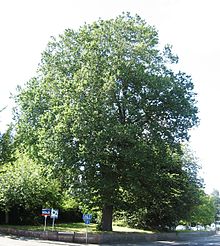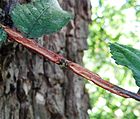- Ulmus × hollandica 'Major'
-
Ulmus × hollandica
Ulmus × hollandica 'Major', Brighton, UK.Details Hybrid parentage U. glabra × U. minor Cultivar 'Major' Origin northern France and Low Countries; (as cultivar) England Although all naturally occurring Field Elm (Ulmus minor) × Wych Elm (U. glabra) hybrids are loosely termed 'Dutch elm' (U. × hollandica), Ulmus × hollandica 'Major' is a distinctive cultivar that in England came to be known specifically as the Dutch Elm. In origin a hybrid elm of Picardy and northern France, where it was known from the fifteenth to nineteenth centuries as ypereau or ypreau,[1] the tree was introduced to England from Holland in the late seventeenth century as a fashion-elm associated with William & Mary[2], the name ‘Dutch Elm' having been coined by Queen Mary's resident botanist Dr Leonard Plukenet[3].
Contents
Description
In areas unaffected by Dutch elm disease, 'Major' often attains a height of > 30 m, with a short bole and irregular, wide-spreading branches. In open-grown specimens, more 'sky' may be seen through the branches of 'Major' than though the crowns of English elm or wych elm - a useful diagnostic feature. The bark of the trunk is dark and deeply fissured, and like English elm, forms irregular 'plates' in mature specimens, serving to distinguish it from the Huntingdon Elm, the other commonly planted U. × hollandica in the UK. [4] [5]
The leaves are oval, < 12 cm long by 7 cm wide, the top surface dark green and glossy, with a long serrated point at the apex. The red apetalous, perfect, wind-pollinated flowers are produced in spring in large clusters of up to 50. The obovate samarae are up to 25 mm long by 18 mm broad. The cultivar may be distinguished from other elms by the corky ridges which on mature trees occur only on the epicormic branches of the trunk. On immature trees and suckers, the corky bark is more pronounced.
Dutch Elm suckers are sometimes confused with English, which may explain the widespread and random occurrence of the former in hedgerows in southern Britain. 'Major' comes into leaf some three weeks later, and loses its leaves some three weeks earlier than English elm,[6] and when young, is straighter, stouter and more open in its branching. It is usually more vigorous than the latter. The larger, tapering leaves, predominantly corky bark, and bold herringbone outline of Dutch Elm suckers also help to distinguish them from those of English elm.
Pests and diseases
Ulmus × hollandica 'Major' is very susceptible to Dutch elm disease.
Cultivation
The ‘Dutch’ elm quickly became popular in eighteenth-century estate plantations in England, survivors today being naturalised relics of this planting fashion; but the tree was always rare in the Netherlands, where from the eighteenth century hollandse iep (Holland elm) meant the widely-planted hybrid Ulmus × hollandica Belgica (Belgian Elm).[1]
The seed is rarely viable, but the tree suckers profusely from roots [1][7][8]. In the south of Britain, 'Major' is commonly found as a sucker, sometimes in mixed hedgerows with English Elm, U. procera. Large Dutch Elm sucker-populations have been found in south west Wales, Cornwall and along the south coast of England. Mature trees are rare, except in Brighton and Hove, East Sussex; The Level, in Brighton, alone has over 80 specimens in a double avenue. Other fine trees can be seen in the city along the London Road and in private gardens. There are also good examples in Edinburgh along Fettes Row, and a single mature 'Major' survives at the extreme east end of Princes Street Gardens (2010).
In North America 'Major' is grown at several arboreta and along the streets of Portland, Oregon. The cultivar is also grown in parks in Australia, notably Melbourne, and New Zealand. 'Major' is also known to have been marketed (as U. montana gigantea) in Poland in the 19th century by the Ulrich nursery [9], Warsaw, and may still survive in Eastern Europe.
Etymology
The epithet 'Major' was first adopted by Smith in Sowerby's English Botany 36: t. 2542, published in 1814, identifying the tree as Ulmus major. Krüssmann formally recognized the tree as the cultivar U. × hollandica 'Major' in 1962 [10]
Synonymy
- Ulmus × hollandica 'Hollandica': Richens [1]
- Ulmus montana (: glabra) var. gigantea Hort.: Kirchner [3], in Petzold [4] & Kirchner, Arb. Muscav. 564, 1864
- ?Ulmus montana (: glabra) var. macrophylla fastigiata Hort.: Nicholson, Kew Hand-List Trees & Shrubs, 2: 141, 1896
- Ulmus praestans: Beterams, Mitt. Deut. Dendr. Ges. 20: 250, 1911
- ?Ulmus × hollandica Ypreau: Richens [1]
Accessions
North America
- Arnold Arboretum. Acc. no. 241-98, from cultivated material.
- Longwood Gardens. Acc. no. L-0600, unrecorded provenance.
- Morton Arboretum. Acc. nos. 1114-25, 338-46.
Europe
- Brighton & Hove City Council, UK, NCCPG Elm Collection. Over 1000 trees, the finest on the Preston/London Road (A27) which are the TROBI UK Champions. Other locations include The Level, Royal Pavilion Gardens, Old Steine War Memorial, Freshfield Road (pollards), Surrenden Road, Ovingdean Hall School, Park Crescent Gardens, Hove Park, Woodvale Cemetery, and St. Nicholas churchyard.
- Edinburgh, Scotland, UK. Trees at the Bruntsfield Links and The Meadows.
- Royal Botanic Gardens Wakehurst Place, UK. Acc. no. 1973-20146.
Australasia
- Avenue of Honour, Ballarat, Australia, as 'Hollandica'.
- Eastwoodhill Arboretum [5], Gisborne, New Zealand, 10 trees, details not known.
Nurseries
Australasia
- Established Tree Planters Pty. Ltd., Wandin, Victoria, Australia. [6]
References
- ^ a b c d e Richens, R. H., Elm (Cambridge, 1983), p. 53-54 also 33, 42.
- ^ Rackham, O. (1976). Trees and Woodland in the British Landscape J. M. Dent, London.
- ^ Armstrong, J. V. & Sell, P. D. (1996). A revision of the British elms (Ulmus L., Ulmaceae): the historical background. Bot. J. Linn. Soc. 120: 39-50.
- ^ Ulmus × hollandica 'Major' in the Botanical Gardens, Christchurch, New Zealand; detail of 'plated' bark: nl:Bestand:Ulmus hollandica.jpg
- ^ Mitchell, A. (1974). A Field Guide to the Trees of Britain & Northern Europe. Collins, London. ISBN 0 00 219213 6
- ^ Elwes, H. J. & Henry, A. (1913), The Trees of Great Britain & Ireland, Vol. VII, p.1885 Private publication. [1]
- ^ Bean, W. J. (1981). Trees and shrubs hardy in Great Britain, 7th edition. Murray, London.
- ^ Elwes, H. J. & Henry, A. (1913). The Trees of Great Britain & Ireland. Vol. VII. pp 1848-1929. Private publication. [2]
- ^ Ulrich, C. (1894), Katalog Drzew i Krezewow, C. Ulrich, Rok 1893-94, Warszawa
- ^ Krüssmann, G. (1962). Hand. Laubgeh. 2: 537.
Categories:- Elm cultivars
Wikimedia Foundation. 2010.


